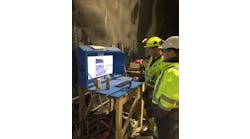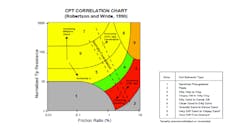By the end of this year, southeast Missouri will be the home of the newest cable-stayed bridge in the U.S. and the longest cable-stayed span over the Mississippi River. The 3,956-ft-long Bill E. Emerson Memorial Bridge, named for the southeast Missouri congressman within days of his passing, will span 1,150 ft and provide more than 60 ft of vertical clearance over the navigation channel.
This is not, however, simply another cable-stayed bridge. Cape Girardeau, Mo., is located approximately 50 miles from New Madrid, Mo., the location of the most violent series of seismic events on record--and the bridge is a candidate to experience a significant earthquake during its 100-year design life. During the winter of 1811-12, this region was rocked by more than 2,000 total events, over 200 of which were considered to have been moderate to large earthquakes; the three most significant earthquakes having surface wave magnitudes (Ms) of about 8.6, 8.4 and 8.7. It is estimated that the recurrence interval of magnitude 8 quakes in this region is between 550 and 1,200 years. Further complicating the design of the Bill E. Emerson Memorial Bridge is the potential for liquefaction and lateral spreading at the Illinois bank, the probability of deep scour and the potential of a barge collision with any of the bridge piers.
In 1991, the Missouri Department of Transportation selected HNTB Corp., Kansas City, Mo., to conduct a structure-type selection study for the new Mississippi River bridge at Cape Girardeau. This study considered the cost and construction methods for various bridge types including a through-truss, a tied arch and a cable-stayed span. The study also included variable span lengths, the location of the major foundations within the river and the cost implications of several foundation types and locations combined with the different superstructures and span lengths.
From this study, it was determined that the most cost-effective solution would be a 1,150-ft cable-stayed navigation span with conventional steel or concrete girder approach spans on the Illinois side of the river. The structure has an overall length of 3,956 ft and is composed of a three-span, 2,086-ft steel and concrete composite cable-stayed unit and 1,870 ft of conventional composite steel plate girder approach structure.
What lies beneath
Geologically, the bridge is located on the eastern edge of the Ozark uplift and the southwestern boundary of the Illinois basin. The bedrock formations at the site are mostly limestone, with minor amounts of shale, upon which the new bridge is founded. On the west side of the river, the limestone is very near the surface, dipping to a depth of over 100 ft near the Illinois abutment. In Illinois, the limestone is overlain by a granular, liquefiable material. Structurally the area is heavily faulted, and most faults are considered to be normal faults. However, some movement is thought to have been strike-slip movement. Although the faults are considered inactive, some of the faulting is thought to be as recent as Holocene.
Although earthquakes occur in other parts of the eastern U.S., the New Madrid region has been the most seismically active region east of the Rocky Mountains. Since the events of the winter of 1811-12 there has been significant research conducted and it has been determined that for a 90% probability of not being exceeded in 250 years, the peak rock acceleration at the site is approximately 0.36 g. Based on input from the project design team, MoDOT selected this as the design event. Considering that Ms 8 or larger events are anticipated every 550 to 1,200 years, the design earthquake is essentially a repeat of the 1811 and 1812 events.
With this in mind, exploratory borings were made and shear wave and compression wave velocity tests were conducted to develop three separate spectrum compatible, site-specific acceleration time histories for the seismic analysis of the bridge. Each earthquake time history was established for two orthogonal directions giving consideration to the effect of spatial incoherency and the directional uncertainty of the design event. Although the vertical component of the design earthquake was not directly considered, it was included in the model by application of a percentage of one of the horizontal accelerations in the vertical direction simultaneously with the separate horizontal components.
As previously noted, the Illinois side of the site consists of up to 100 ft of primarily loose to medium-dense sands. Both the comprehensive geotechnical investigation and the site-specific seismic investigation revealed Standard Penetration Test blow counts as low as 4 with only thin seams of material having blow counts above 16 in the upper 70 to 100 ft of alluvium. With these poor soil conditions and the high level of shaking that is expected to occur during the design earthquake, widespread liquefaction is anticipated to a depth of up to 70 ft below grade.
Because of the gently sloping banks, particularly between the main channel and the levee on the Illinois shore, lateral spreading is anticipated along with the liquefaction and the banks could flow as much as 10 ft toward the channel while in a liquefied state. Clearly, this would produce exceptionally large horizontal forces on the bridge foundations at a time when there is little lateral support.
Finding right foundation
Taken in combination, the site geology, the seismic hazard and selected superstructure types had a significant effect on the selection of foundation types in both the Illinois approach spans and for the cable-stayed navigation unit.
Since liquefaction presents little problem for the cable-stayed unit, it was determined that the most cost-effective foundations for the cable-stayed spans were spread footings or dredged caissons on bedrock.
The eastern approach spans, however, would require a deep foundation system of either driven piles or drilled shafts. Pier 2, the westernmost main tower pier located on the Missouri bank of the river, is founded on a spread footing keyed into rock; Piers 3 and 4 are founded on dredged caissons driven to bedrock.
Dredged caissons were selected for Piers 3 and 4 for a number of reasons, including the severity of the design earthquake. Had drilled shafts been selected, the combined depth of the pile cap and tremie seal would have left only a few feet between the top of rock and the bottom of the seal causing the shafts to serve as short, stiff elements incapable of resisting the lateral forces resulting from the anticipated seismic event.
The approach spans are considerably different. As noted earlier, these foundations are located in an area with very deep, highly liquefiable soils. When combined, the liquefaction and the depth of anticipated scour eliminated spread footing type foundations from consideration. After extensive studies of various soil improvement techniques, it was determined that any soil improvement would be ineffective due to repeated degradation and aggradation of the channel.
Thus, both spread footings and driven steel piles were eliminated as viable foundation alternatives, which led to the selection of large diameter drilled shafts socketed into rock.
It's hard to move
The initial bridge analysis included both dead-load and live-load analyses to determine preliminary member sizes, although the final dead-load runs were made by "building" the bridge via computer to determine the locked-in erection dead-load forces. The remaining analysis results, including seismic analysis results, were superimposed on the erection results in order to determine group load stresses for design.
The initial earthquake design runs for the cable-stayed unit indicated that without any longitudinal restraint at the tower piers, the design preference, the bridge would experience movements up to 48 in. in each direction at the ends of the unit.
It was determined that the most efficient method to resist these forces was by providing longitudinal restraint at the tower piers through the use of an earthquake shock transfer device. This device, composed of a cylinder filled with silicon and a piston, is capable of transferring forces in both tension and compression. Therefore, the double-action unit simplified the design of the connections to the structure and permits transfer of earthquake forces at the most efficient elevation. These devices, each capable of transferring 1,500 kips of force, have the added advantage of reducing wind-induced motion of the bridge while improving the stability of the bridge in strong winds and minimizing longitudinal displacements under the various live-load combinations. Reduced movements would then require smaller expansion joint devices and relieve the required movement capacity of the side span tie down devices.
The Bill E. Emerson Memorial Bridge is on track for completion in late 2003. When open to traffic, the bridge will be a much-needed improvement over the narrow two-lane bridge built in 1927 and will provide a significant new link in the region's transportation system.


